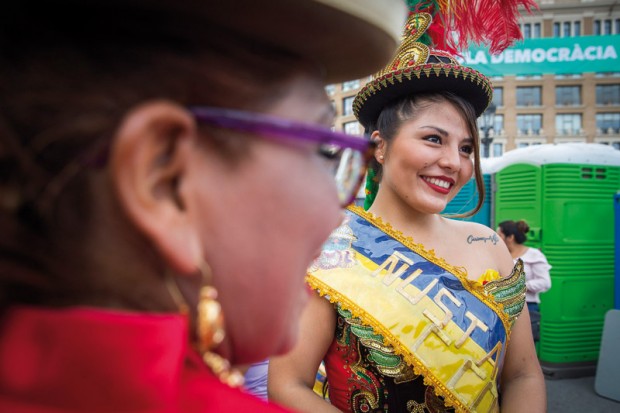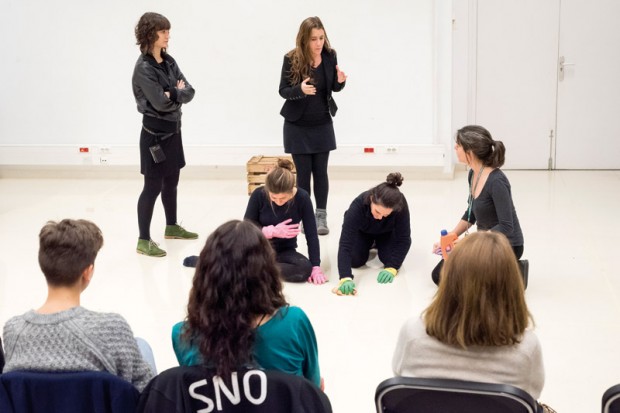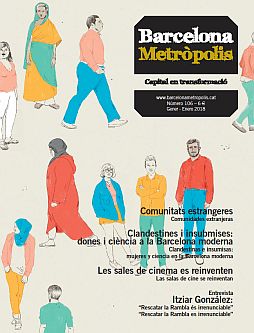
Bolivian women at the Festes de la Mercè in 2017. The diversity and heterogeneity of Latin America is reproduced in the communities from across the Atlantic. There is no single Latin American profile, but a multitude.
Photo: Pere Virgili
Latin American countries share a strong tendency towards participation in associations, and this can be seen in the significant number of organizations created by citizens originally from the other side of the Atlantic. The presence of females is very significant: Latin American women have become key to the maintenance of the welfare of the native population.
I’m what they left,
I’m all that’s left over from what they robbed.
A people hidden on the summit,
my skin is leather, so I can resist any climate.
I’m a smoking factory,
peasant manpower for your consumption.
A cold front in the middle of summer,
love in the time of cholera, my brother.
Fragment of the song Latinoamérica, by Puerto Rican group Calle 13
This dossier couldn’t be missing an article on Latin Americans in Barcelona. I was assigned this task as a Colombian who has lived in the city for the past eleven years. I found this to be a challenge requiring respect and great care. With this in mind, let’s begin with a few clarifications and definitions.
First of all, although it may seem obvious, we should remember that Latin America is NOT a country. At least for the time being, there is no Latin American nationality. Latin America or Abya Yala1 is a region made up of 20 countries and seven dependent territories inhabited by approximately 626 million people. Any generalizations about a region full of diversity and contrast are questionable. As a matter of fact, there are some people who even question whether Latin America is a reality or a myth.
Second, the expression “Latin America” covers an extremely complex reality, with almost as many differences as similarities. As a result, if we place the emphasis on differences and regionalism, we can deny the existence of Latin America altogether, as well as the essential unity stemming from its very diversity. There isn’t one Latin America, there are as many as there are countries or sub-regions that make it up. Therefore, any attempt to reduce it to a single entity is nothing more than acceptance of a myth or a fiction.
Third, this diversity inherent in the region is, of course, also manifested in the heterogeneity of the histories and the realities of the Latin Americans living in Barcelona. Therefore, those of us with a Latin American origin or baggage don’t make up a homogeneous group, and, therefore, our realities vary widely. As a result, this article has no intention of speaking “in the name of the Latin American community”. In any case, it is an attempt to take a look at the broad diversity of realities we experience.
Last but not least, I would like to comment on certain legal mechanisms, such as bilateral or multilateral agreements and treaties, specificities in immigration and naturalization laws, regional cooperative organizations, etc. These make Latin American immigrants into an “other” who is still compatible with the native population as a result of a supposed cultural proximity or brotherhood forged through the colonial and post-colonial history shared with Spain and Catalonia. As a result, Latin American immigrants are incorporated into the public imagination as both different and recognizable. For the native, Latin Americans continue to constitute a form of otherness reflected in the legal arena (with the restriction of rights for non-nationals) the economic (insertion into precarious and segmented job markets) and the social (significant problems with housing, participation, etc.).
Nevertheless, at the same time an image of the Latin America is constructed that sees them as closer than the other immigrant groups and —according to this idea— as more easily integrated. Therefore, when compared with groups like sub-Saharans, Asians or North Africans, both in Spain and in Portugal, Latin Americans are treated, both rhetorically and in practice, as “closer” or “less foreign”. This carries significant consequences for their legal, economic and social integration.
Waves of Latin American immigration
The most important migrations of Latin Americans in Spain in general and Catalonia in particular are concentrated in the last quarter of the 20th century, motivated in some cases by factors like violence, economic crises or political instability. In the seventies, political exile characterized the first migratory wave of Argentines and Chileans; Cubans, Brazilians and some Uruguayans also stand out during this period. Later on, in the ‘80s, the immigration was led by those from Colombia, Ecuador, the Dominical Republic and Peru, and in the early ‘90s primarily Uruguayans and Paraguayans immigrated.
The signing of bilateral agreements to regulate the flow of migrants with several Latin American countries like Colombia, Ecuador or the Dominican Republic, and the application of the Law of Grandchildren (which allowed for the children and grandchildren of Spaniards exiled during the dictatorship to obtain citizenship) promoted a new migratory wave where Venezuelans, Argentines and Cubans predominated.
Two final considerations: the period from 2002-2004 was when this population grew the most, and in these migrations social networks have played a key role.
Latin Americans here and today
According to data from the Department of Statistics of the City Council, around 79,254 individuals from countries in the aforementioned region live in the city. These figures have dropped over the past few years, and do not include Catalans with Latin American families. We would like to insist on the idea that there is no single Latino profile. For example, there are nearly four thousand Mexicans residing in the Catalan capital, and 90% of them come to Barcelona to study; on the other hand, the members of the Ecuadorian and Bolivian communities generally come over for economic reasons.
Of the figure mentioned above, over 60% are women, and half are adults between 25 and 39 years of age; 12.25% are young women. Almost 60% of Latin American women have a higher secondary education, mid-level professional training or university studies. On the other hand, Bolivia, Honduras, Peru, Colombia and Ecuador are the countries with the greatest impact on our city’s districts, as the women of these nationalities make up 51% of the total number of Latin American women.
This feminization of Latin American migration has caused Latin American women to become a key group in the process of maintaining the welfare of the local population. Many of them work in personal care, taking care of issues like dependency, maintenance of the demographic structure of the working world or the access of local women to the job market. This is a significant and often hidden contribution that these women make to the city. We should also note that often, these tasks are executed in precarious conditions that make life more precarious for this group. There are unions like SindiLlar and organizations like Mujeres Pa’lante that allow Latin American women to organize together with women of other origins to defend their working rights, to create care spaces for themselves and to generate other projects.

Workshop with the Les Oprimides theatre group, a joint initiative of the La Xixa Teatre Association and the Sindillar domestic and care workers’ union, with a marked Latin American presence. The workshops, held in the Francesca Bonnemaison centre, are intended to tackle the inequalities suffered by this collective through dramatisation.
Photo: Dani Codina
It is curious that most of the studies on the Latin American public (which are not at all abundant) tend to focus on information referring to the “adult world”. In other words, issues having to do with work, power relationships and reasons for emigrating. Except for a couple of obsolete studies on gangs, there seems to be a gap in the research on adolescents and young people who came over with their families or were born in the city. An in-depth investigation is needed on the initiatives and contributions in several areas (business, politics, associations, culture, sports) by Latin American youth.
A very social population
The notable tendency to participate in associations is one of the strong points shared by Latin American countries. The organizations and collectives that predominate are cultural, social, sporting, environmental, religious, political and student. The contributions in the cultural and social realm, however, don’t pass over into politics. Many of these organizations are present in institutional spaces like the Municipal Council on Immigration, but we need to create strategies to overcome the barriers of institutional racism and promote the same kind of presence in other decision-making spaces. Similarly, Latin American participation in movements such as those opposing racism or for the closing of Foreigner Internment Centres (CIE) is notable. In these spaces, knowledge and rhetoric is generated that help to constitute and strengthen these individuals as real political subjects.
In terms of nightlife, Latin rhythms gain popularity by the day. Proof of this is the growing number of clubs and discos that organize sessions and concerts of salsa, bachata, reggaeton, cumbia, merengue and mambo music. We still have a ways to go, however, with the presence of Latin Americans on the ballot, where they are currently almost non-existent. This leaves us in a situation of invisibility, and, above all, it denies us the ability to enrich political debate in the city with knowledge, rhetoric, decision-making mechanisms and other elements we could contribute thanks to our diversity and internal richness.
For now, the night has been Latinized in Barcelona, but we need to do the same in politics, in decision-making spaces, social movements in general, the business world, neighbourhood assemblies… By “Latinize”, I mean not just being allowed to be present, but for our way of doing things to enter into dialogue with how things are currently done and transform them, interacting with those of citizens with different migratory or cultural baggage. From my point of view, our way of doing things is based, among other things, on a strong critical sense, the notable importance we place on the group and the “defence of joy like in the trenches”, in the words of Mario Benedetti.
Note
1. Abya Yala is how the continent we know today as America was known before colonization. This name means, literally, full-grown land or land of lifeblood.



interesante, como inmigrante me siento reflejada y más realizo un trabajo final de máster tema migraciones